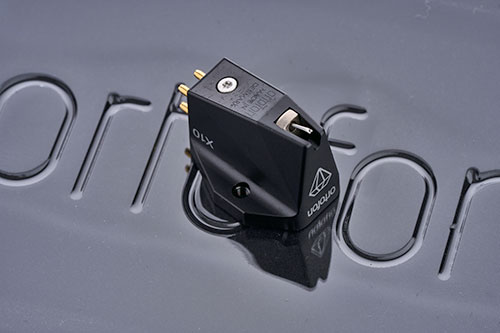Thanks to Melco, I haven't played my ripped CDs and high-resolution audio files on a computer for years. In the meantime, the Japanese digital specialists offer not only various music servers and network players, but also a switch optimized for audio applications.
In my wife's chain located in the living room an N1A 60HA/2 provides the data, while in the my listening room it's an N1Z 60HA/2 taking over the job, and for ripping CDs my colleagues and I use the D100 transport, our so-called „editorial ripper“. Since I am utterly convinced by Melco’s triumvirate, I tried to get hold of the Switch as quick as possible. Roland Dietl already described the extent to which a representative of this guild can contribute to a harmonious sound three years ago in the first review of the Aqvox AQ-Switch-8. With the SE version, Aqvox designer Norman Lübke proved that it can be done even better. The Telegärtner M12 Switch Gold then lifted my digital chain to an even higher level – but it required a quite considerable investment and the conversion to LAN cables with M12 connectors on one end. After that, there were no qualms at all: Roland Dietl reviewed SOtM's switch, the sNH-10G, in a setting of the brand's components and did not shy away from connecting the 10 megahertz clock sCLK-OCX10 for clocking the switch - and got so enthusiastic about its effect on his digital playback chain that I tried the set in my system as well. And again, I found myself entirely convinced. Maybe it's hard to convey to other music lovers or analogue afficionados, but my colleague and I have each purchased a SOtM set for our systems: After all, we still want to be able to reach those potential pinnacles of musical enjoyment with what once started as "computer hi-fi".

But let’s step back to Melco’s S100. To get a better understanding of the matter, it might be helpful to briefly recall the roots of the company, even if I had already mentioned them in the article about the HA-1NA: Back in the 70's there existed a sensational Japanese turntable whose modular construction can be considered as the paragon of some non-suspended turntables introduced hereinafter. Makoto Maki had designed it, whose last name also stands for the first letter within the company name: Maki Electronic Laboratory Company or, in short, Melco. In the meantime, his company developed into the largest manufacturer of computer peripherals in Japan. Wireless routers, Ethernet data switches and storage media are offered under the brand name Buffalo. So Melco or Buffalo respectively should have sufficient competence in the field of switches. It’s therefore not really surprising that the Japanese digital specialists take a completely different approach than the manufacturers of all the switches mentioned above.

-
Ortofon MC X10
Der renommierte Tonabnehmer-Hersteller Ortofon implementiert die Gene seiner großen MC-Systeme in die neue Einstiegsserie „X“ und bettet sie in ein innovatives Gesamtkonzept. Wir testen das günstigste Modell MC X10 zum Preis von 300 Euro, das bereits mit technischen Finessen wie um 90 Grad gedrehten Reinsilberspulen aufwartet. Wie sehr liebe ich Ortofon! Es gibt keinen anderen Tonabnehmer-Hersteller, von dem ich im Prinzip jedes Modell blind kaufen würde. Und dies bereits zur Genüge auch getan habe. Der…08.07.2025 -
WestminsterLab Lumin Power X1 DC Cable
Auch wenn dies bereits der fünfte Artikel ist, der Erzeugnisse von WestminsterLab zum Gegenstand hat, ist es der erste, in dem es um ein Kabel geht – und was für eins: ein Gleichstromkabel für die Verbindung von Netzteil zum Hauptgerät eines einzigen Herstellers: Lumin. Noch dazu ist das Kabel in Relation zu den Geräten recht kostspielig. Ich gebe gerne zu, dass ich von allein niemals auf die Idee gekommen wäre, mich mit WestminsterLabs Lumin Power…04.07.2025 -
Acousence dac-pre reference UX
In vielen meiner Tests kommen Produkte von Acousence vor, wenn auch nicht namentlich. Denken Sie nur an Schostakowitschs Symphonie Nr. 15 mit den Duisburger Philharmonikern: ein vorzügliches klingendes Album, egal ob als File oder als LP. Doch Acousence steht nicht nur für Aufnahmen, sondern auch für Hifi- und Studio-Equipment der etwas anderen Art. Der Kopf hinter Acousence – ein Kunstwort aus „acoustics“ und „experience“ – ist Ralf Koschnicke. Er betreibt ein Tonstudio, ist Mitglied im…01.07.2025 -
Goldring Ethos SE
Seit dem Bestehen von hifistatement – und das sind nun auch schon 14 respektive 16 Jahre – testeten wir einen einzigen Goldring-Tonabnehmer: Dabei tauchte das Elektra nur kurz im zweiteiligen Berichts über den Transrotor Crescendo auf. IDC Klaassen, der neue Goldring-Vertrieb, wollte das ändern und schickte das aktuelle Topmodell nach Gröbenzell. Auch wenn es in der Einleitung ein wenig anders erscheint, haben die Kollegen und ich schon durchaus Erfahrungen mit den Systemen oder zumindest den…24.06.2025 -
Transparent Audio XL Power Cord
Als ich kürzlich Luis Fernades und Werner Möhring in Meschede besuchte und wir den Test der Finite Elemente Carbofibre° Statement verabredeten, schlug der Geschäftsführer des G8-&-Friends-Vertriebs vor, auch mal eines der besseren Stromkabel von Tranparent auszuprobieren. Doch wie testet man ein einzelnes Netzkabel in einer gut abgestimmten Kette? In meiner Anlage versorgt fast durchgängig von Garth Powell entwickelte Netztechnik der Marke Audioquest die Komponenten mit Energie. Allerdings ist seit der ungemein aufwendigen Beschäftigung mit den…20.06.2025 -
SilentPower Omni LAN
Welch positive klangliche Auswirkung die Synchronisation mit einer 10-Megahertz-Clock hat, haben Roland Dietl und ich an dieser Stelle schon häufig beschrieben. Allerdings bewegten sich beispielsweise alle dafür geeigneten Switches im gehobenen vierstelligen Preisbereich. SilentPowers Omni LAN hat einen Clock-Eingang und kostet gerade mal 800 Euro. Wer vielleicht durch Wolfgang Kempers Test des SilentPower LAN iPurifiers Pro mitbekommen hat, dass SilentPower eine Untermarke von ifi ist, kann sich gewiss erklären, warum das Omni-LAN-Switch trotz seiner vielfältigen…17.06.2025
© 2025 | HIFISTATEMENT | netmagazine | Alle Rechte vorbehalten | Impressum | Datenschutz




























 |
|
































































































